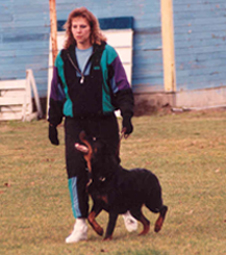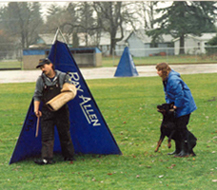Dreibergen Rottweilers
What is Schutzhund/Veilseitigkeitsprüfung/IPO
Schutzhund/Vielseitigkeitsprüfung/IPO (SchH/VPG/IPO) was instituted in Germany in the early 1900s as a temperament test for a dog's suitability for police or military work. It was designed to assess whether or not a dog possessed the necessary inherited characteristics for the work so that breeders could evaluate and pick only the suitable dogs for their breeding programs. It is a challenging test of the dog’s character. Today this remains a required test in many countries for breed worthiness for the working dog breeds deemed suitable for police work and IPO is also an all breed sport with local, regional and international competitions for all breeds of dogs with the proper working abilities and temperament for the sport.
The name of the test has been modified several times, from Schutzhund, translated to Protection Dog, to Vielseitigkeitsprüfung which translates to versatility examination for working dogs. In 2012, the FCI Utility Dog Commission adopted rules, the "Guidelines for International Utility Dog Trials" which are now the official rules of the dog sport world wide and bring consistency and uniformity to rules that govern the sport. Some national organizations have slight variances to the rules but overall they remain consistant throughout the world.
Some of the traits tested are the dog’s desire to work, intelligence, trainability, perseverance and a strong and proper relationship with the handler. It also tests physical traits such as strength, endurance and agility.
The sport is a complicated, three level, three phase test and the performance is evaluated by qualified judges on a points system. There are three levels of titles and three phases to each title. A passing score must be achieved in all three phases at a single trial in order to obtain the title and advance to the next training level. The basic titles are IPO 1, IPO 2 and IPO 3, the highest and competition level. Obedience is emphasized in all three phases and any time the judge may dismiss a dog for lack of control or for showing pressure in the exercises as well as improper temperament, including fear or aggression.
Before a dog can compete for a SchH/VPG1, the dog must pass a temperament test called a BH (Begleithundprüfung) which translates as traffic-sure companion dog test. The BH tests basic obedience, on and off leash and sureness around strange people, strange dogs, traffic, bicycles, joggers and loud noises. A dog that exhibits excessive fear, distractibility, or aggression cannot pass the BH and so cannot go on to compete in higher levels of the sport.
Phase 1 - Tracking: In this phase the dog must draw from inherited abilities by using their nose to find where a person has walked (a track) and discover articles, normally wood, leather or carpet, that have been placed in various spots on the track at along the way. Depending on the level, the tracks vary in length, shape and age. Tracking is usually done on dirt or grass. A perfect score is 100 points with a minimum score of 70 points needed to pass. Tracking not only relies on the dog’s natural scenting ability but also tests mental soundness, willingness to work, endurance and obedience.

Phase 2 - Obedience: The obedience phase involves numerous and demanding exercises which is done entirely off leash on a soccer sized trial field. The obedience exercises include a long heeling pattern demonstrating normal, fast and slow pace, two about turns, a left turn, a right turn, heeling through a group of people and two halts. During the heeling there is also a gunfire test, the working breeds must be "indifferent" to gunfire. There are motion exercises including a sit, a down and a stand demonstrated while the handler remains moving forward, in some levels while at a running pace. There are recalls with finishes, retrieving on the flat ground, retrieving while jumping over a one meter jump and retrieving ove ra six foot wall. The obedience phase ends with a directed send away with the dog commanded to a down at the far end of the field from the handler. There are two dog and handler teames on the field at the same time, one dog is on a long down "under distraction", while the other dog handler team is performing the obedience exercises. Then the teams trade places, one dog on a down while the other performes the exercises. The set pattern is demonstrated by the handler from memory. A perfect score is 100 points with a minimum score of 70 points needed to pass. The dog must demonstrate enthusiasm and teamwork with the handler and any stress or pressure shown by the dog during the obedience exercises is heavily penalized.

Phase 3 - Protection: This phase of training is very intricate, advanced and taught with absolute control in mind. It should not be confused or compared in any way with "guard dog" training. The dog must prove to have a reliable temperament and must show tractability as well as courage to protect himself and his handler and his ability to withstand pressure. A dog that shows fear, lack of control, or inappropriate aggression is dismissed. The "helper" as he is known in the sport, always wears protective leather pants and a special sleeve with a jute cover. The dog is only allowed to bite this sleeve when either the dog or the handler is “attacked” by the helper and he must only bite in the correct manner demonstrating a proper grip without hesitation. On command the dog must release the bite, a dog will fail if it does not release the bite when commanded to do so. The sport dog is never permitted to show aggression except under these specific situations it is trained to face, and even then it must always be under the absolute control of the handler. A perfect score is 100 points with a minimum score of 70 points needed to pass.
Competing with a dog in the sport is like preparing for an Olympic event. It is physically demanding on the dog and the dog must be prepared like and athlete with consideration for all of the aspects of conditioning, proper diet and the psychology of dog training and competition.
Dogs of any breed, even mixes, can compete in in the sport, but the most common breeds are German Shepherds, Belgian Malinois, Rottweilers, Dobermans, Boxers, Giant Schnauzers, Bouvier des Flandres, and Dutch Shepherd Dogs. There are breed clubs for the various breeds in the U.S. that are members of the American Working Dog Federation. Many of these breed clubs have member local clubs that are active training clubs.
The best source of training information is a good sport club. The overwhelming majority of IPO training is done by owner/handlers at local clubs. The more experienced members help the novice members however the training director of the club has the ultimate responsibility to the dog, handler, club, and society to constantly evaluate every dog and to decline to train any dog with questionable character or working ability. Training a dog that does not really want to work is stressful and frustrating for all parties involved. A good club is a necessity for proper sport training. Clubs regularly hold public trials, providing the opportunity for dogs to earn titles and for handlers to assess their training progress.
This article is protected by copyright and may not be reproduced online or in print, in whole or in part without prior consent of the authors.